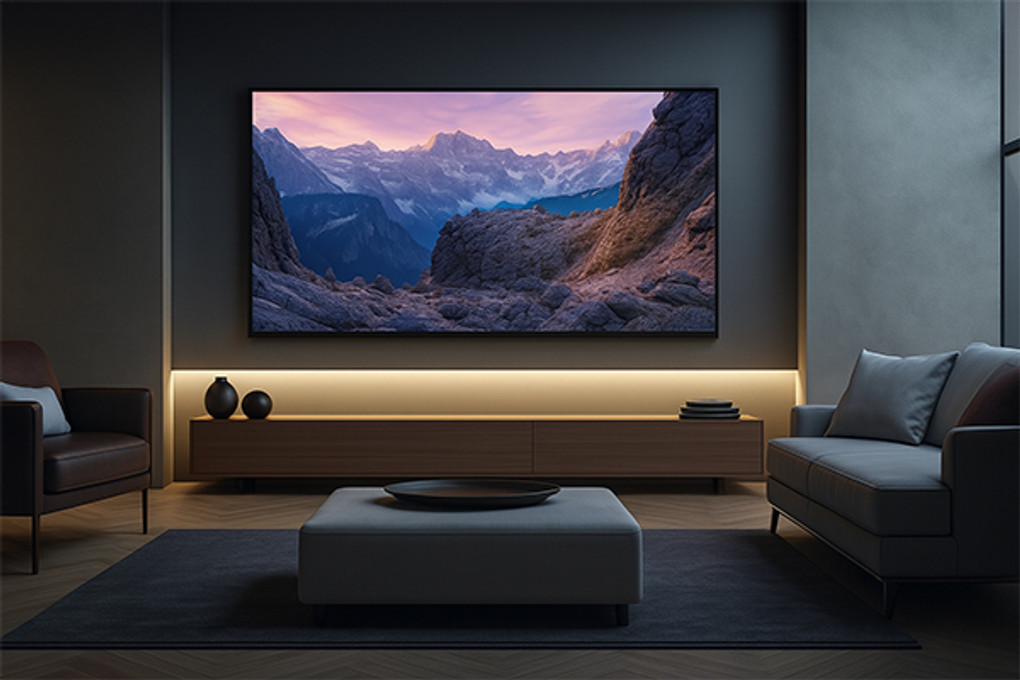
Where To Position LED Strip Lights On A Media Wall
Posted by Navdip Gahir on 25th Jul 2025
When done right, LED Strip Lights can take your home from “lovely” to “WOW” with pretty minimal effort. All it takes is a run of tape at a desk, behind a headboard, or under a kitchen plinth to really transform it.
Of course, TVs and media walls also fall under this bracket, and nowadays these are some of the most popular places for LED tape installations.
It’s not just the tape itself though - it’s also where you use them and how. As far as media walls are concerned, getting the positioning right can make it look like the lighting was built into the wall from day one.
Behind The TV
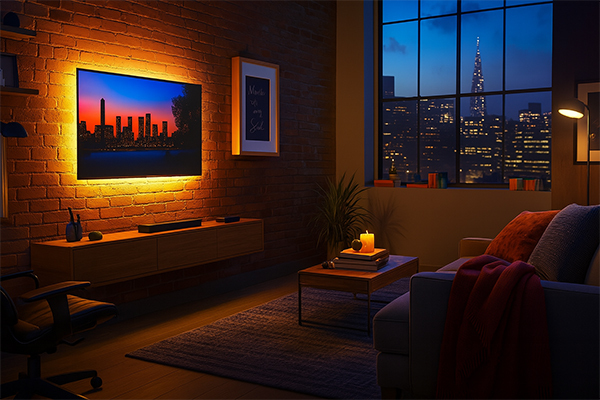
One of the easiest and most effective places to use LED strips for a media wall is by mounting them directly to the back of your TV.
This creates a subtle backlight that adds a soft halo around the screen, and can actually help reduce eye strain, by spreading the light you’re seeing across a wider area.
For a setup like this, we’d recommend either Warm White 3000K tape, or RGBWW tape if you want to create moods, or also use your media wall for gaming sessions too.
Recessed Shelves & Alcoves
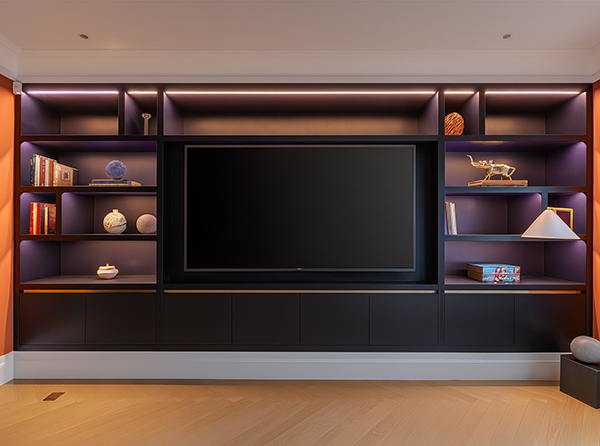
Using LED strips in shelves and alcoves can bring architectural features to life, and really add a different dimension to your media wall.
You’ve got two options here: downwashing and upwashing.
Downwashing is where your tapes are installed at the top of your shelving or alcove, and ‘wash’ the light downwards, which looks pretty spectacular.
Upwashing is the opposite, where your tapes are installed at the bottom of your shelves or alcoves, and wash the light upwards. This looks equally good, and also makes any ornaments pop.
We’d recommend RGB+CCT tape for something like this, as shelf/alcove lighting is generally used for ambience, and having the option of millions of different colours allows you to create any kind of mood lighting you want.
Floating TV Units
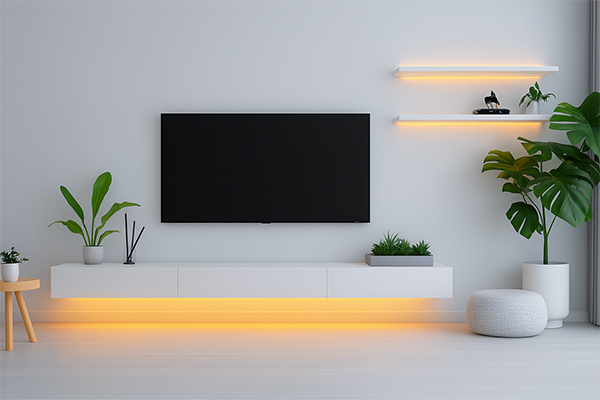
Now we’re getting onto some really high-end look lighting, with minimal effort.
Floating TV units and cabinets are also an incredibly popular choice nowadays, because of the modern, minimalist look they give your space.
By simply mounting your strips directly underneath your floating TV unit, the lighting can add to that floating effect, which looks even better in rooms with darker colour choices.
In a nutshell, this location gives your space that really high-end, “hotel-lobby chic”, using one very simple and relatively short run of tape.
We’d recommend either Warm White 3000K or Day Light 4000K tape for this, for that natural look.
Inside Panel Gaps
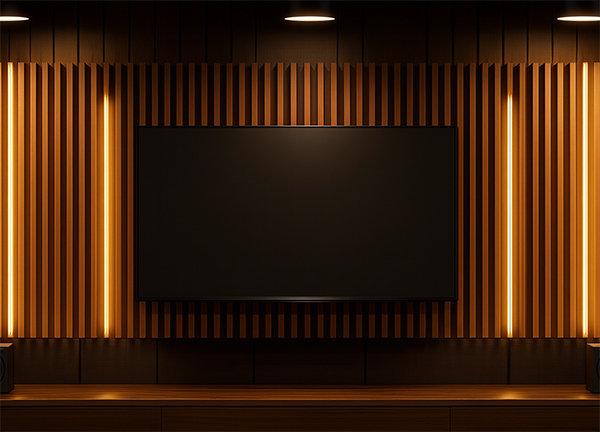
This is also a really premium looking solution, if you’re using panels on your media wall.
Installing your strips inside the gaps between each plank on your media wall can really create that architectural lighting look.
The great thing here is that you have quite a bit of freedom with the lengths that you run. If you want full, floor to ceiling runs, you can. Or if you want staggered runs that gradually decrease in length, that’s also totally possible too.
There are a couple of things to bear in mind here though. First is that as the tape will be in plain view, COB strip lights are essential. The last thing you want is dotted lighting out in the open.
The second thing is that being able to dim your lights is also crucial. Panel gap lighting can look amazing, as long as it’s not overpowering and creating more glare than you want.
As you’d need multiple runs connected via core cable for a setup like this, we’d recommend getting one of our sales team to put together a quote for this, to make sure the components are exactly right.
Floor Level or Skirting Uplighting
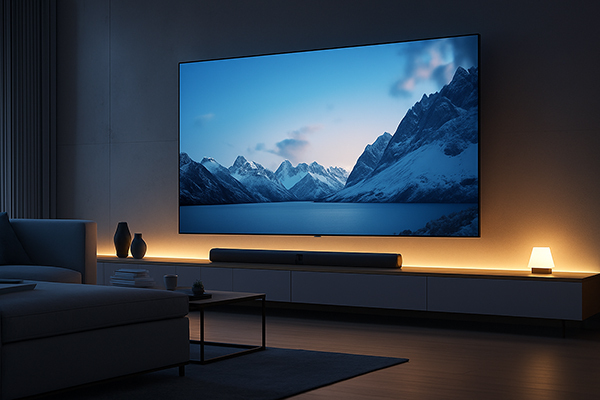
While this option isn’t as common as some of the other choices, it does look very good in large media wall setups.
This style choice helps create a floating wall illusion or soft floor glow, which is another way of having that hotel-lobby vibe in your home.
The best part is that this is another very simple install, involving just one run of tape.
Our recommendations for this would be either Warm White 3000K for general ambience, or RGB+CCT tape for mood creation.
Don’t Forget The Driver
Regardless of which tape you opt for, and where you choose to install the tape, you will need a 24V power supply for your tape.
You can either go hardwired (which we’d recommend getting an electrician to do), or you can opt for an ACDC power adapter and plug it into any 3-pin socket.
Going for the latter means that as long as your plug socket is hidden behind a TV unit, or otherwise out of sight, you won’t see much of your wiring.
If you’re hardwiring your media wall lighting, then you’ll want to hide the driver somewhere. Some suggestions are:
- Behind TV units,
- Inside cabinets,
- Inside wall cavities
Suggestions For A Clean Install
It’s a good idea to have everything planned out in advance, before you commit to a certain type of media wall or lighting setup.
For example, lighting for under a floating TV unit looks very different to lighting the insides of your panel gaps.
Where possible, we would also recommend the use of Aluminium Profiles too, for two main reasons. The first is that Profiles make your tape installation so much neater, by ensuring the lines are perfectly straight, especially if your tapes will be directly visible.
The second reason is that the Profiles also act as a heat sink for the tapes, which means they last longer too.
As mentioned earlier, we’d also advise you to overspec the amount of light you need, as you can always dim it down later if need be. If you opt for a lower wattage tape and find it’s not bright enough, there aren’t many options beyond replacing the tape itself, which could also mean upgrading the driver to one that has a higher max load too.
Expert Advice
Of course, if you are unsure about the best places to install your LED Tape, feel free to just give us a call. Our team are experts in putting together the most complex LED tape quotes, and media walls are a breeze for them.
You can either phone them on 0116 321 4120, or you can send them an email to sales@wled.co.uk.
You can also reach out to us on our Facebook and Instagram pages too. For all things LED lighting, you can also check out our YouTube channel too.





